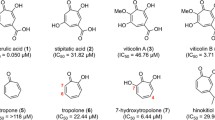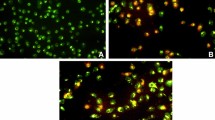Abstract
Astraodorol, a major lanostane-type triterpene isolated from the edible mushroom Astraeus odoratus, was subjected to chemical modifications. Ten derivatives have been synthesized and their biological activities were evaluated. Compounds 5, 6, 7a, 7c, 7e, 7f, and 7 g exhibited strong antimalarial activity with IC50 values of 4.85, 4.48, 4.16, 4.46, 3.45, 3.23, and 3.41 µg/mL, respectively. Compounds 7a, 7c, and 7e showed moderate cytotoxicity against NCI-H187 with IC50 values of 23.36, 34.28, and 9.84 µg/mL. Compound 7e demonstrated moderate cytotoxicity against KB, MCF-7, and Vero cell lines with IC50 values of 16.94, 49.60, and 26.48 µg/mL, respectively.


Similar content being viewed by others
References
Arpha, K., C. Phosri, N. Suwannasai, W. Mongkolthananruk, and S. Sodngam. 2013. Astraodoric acids A–D: new lanostane triterpenes from edible mushroom Astraeus odoratus and their anti-Mycobacterium tuberculosis H37Ra and cytotoxicity. Journal of Agricultural and Food Chemistry 60: 9834–9841.
Babar, Z.U., A. Ata, and M.H. Meshkatalsadat. 2006. New bioactive steroidal alkaloids from Buxus hyrcana. Steroids 71: 1045–1051.
Batista, R., A. De Jesus Silva Junior, and B. De Oliveira. 2009. Plant-derived antimalarial agents: new leads and efficient phytomedicines. Part II. Non-alkaloidal natural products. Molecules 14: 3037–3072.
Brien, J.O., I. Wilson, T. Orton, and F. Opognan. 2000. Investigation of the alamar blue (resazurin) fluorescent for the assessment of mammalian cell cytotoxicity. European Journal of Biochemistry 267: 5421–5426.
Desjardins, R.E., C.J. Canfield, J.D. Haynes, and J.D. Chulay. 1979. Quantitative assessment of antimalarial activity in vitro by a semiautomated microdilution technique. Antimicrobial Agents and Chemotherapy 16: 710–718.
Devkova, K.P., B.N. Lenta, J.D. Wansi, M.I. Choudhary, D.P. Kisangau, N.Q. Samreen, and N. Sewald. 2008. Bioactive 5α-Pregnane-type steroidal alkaloids from Sarcococca hookeriana. Journal of Natural Products 71: 1481–1484.
Dondorp, A.M., F. Nosten, P. Yi, et al. 2009. Artemisinin resistance in Plasmodium falciparum malaria. New England Journal of Medicine 361: 455–467.
Enserink, M. 2008. Lower malaria numbers reflect better estimates and a glimmer of hope. Science 321: 1620.
Foley, M., and L. Tilley. 1997. Quinoline antimalarials: mechanisms of action and resistance. International Journal for Parasitology 27: 231–240.
Glaziou, P., K. Floyd, and M. Raviglione. 2009. Global burden and epidemiology of tuberculosis. Clinics in Chest Medicine 30: 621–636.
Gupta, C., S. Prasad, M. Sahai, T. Asai, N. Hara, Y. Fujimoto, and A.-E. Artabotryols. 2010. New lanostane triterpenes from the seeds of Artabotrys odoratissimus. Helvetica Chimica Acta 93: 1925–1932.
Hunt, L., M. Jordan, M. De Jesus, and F.M. Wurm. 1999. GFP-expressing mammalian cells for fast, sensitive, noninvasive cell growth assessment in a kinetic mode. Biotechnology and Bioengineering 65: 201–205.
Kaur, K., M. Jain, T. Kuar, and R. Jain. 2009. Antimalarials from nature. Bioorganic Medicinal Chemistry 17: 3229–3256.
Noedl, H., Y. Se, K. Schaecher, B.L. Smith, D. Socheat, and M.M. Fukuda. 2008. Evidence of Artemisinin-resistant malaria in western Cambodia. New England Journal of Medicine 359: 2619–2620.
Rathore, D., D. Jani, R. Nagarkatti, and S. Kumar. 2006. Heme detoxification and antimalarial drugs-known mechanisms and future prospects. Drug Discovery Today 3: 153–158.
Seo, H.W., T.M. Hung, M. Na, et al. 2009. Steroids and triterpenes from the fruiting bodies of Ganoderma lucidum and their anti-complement activity. Archives of Pharmacal Research 32: 1573–1579.
Skinner-Adams, T.S., C.M. Stack, K.R. Trenholme, C.L. Brown, J. Grembecka, J. Lowther, A. Mucha, M. Drag, P. Kafarski, S. Mcgowan, J.C. Whisstock, D.L. Gardiner, and J.P. Dalton. 2009. Plasmodium falciparum neutral aminopeptidases: new targets for anti-malarials. Trends in Biochemical Sciences 35: 53–61.
Stanikunaite, R., M.M. Rawan, J.M. Trappe, F. Fronzeck, and S.A. Ross. 2008. Lanostane-type triterpenes from the mushroom Astraeus pteridis with antituberculosis activity. Journal of Natural Products 71: 2077–2079.
Trager, W., and J.B. Jensen. 1976. Human malaria parasites in continuous culture. Science 193: 673–675.
WHO. 2013. World malaria report. Geneva: World Health Organization. 2013.
WHO. 2010. Guidelines for the treatment of malaria, 2nd ed. Geneva: World Health Organization.
Acknowledgments
This work was supported by the office of the National Research Council of Thailand (NRCT), the Centre of Excellence for Innovation in Chemistry (PERCH-CIC), Office of the Higher Education Commission, Ministry of Education and Graduate School of Khon Kaen University.
Author information
Authors and Affiliations
Corresponding author
Electronic supplementary material
Below is the link to the electronic supplementary material.
Rights and permissions
About this article
Cite this article
Nasomjai, P., Arpha, K., Sodngam, S. et al. Potential antimalarial derivatives from astraodorol. Arch. Pharm. Res. 37, 1538–1545 (2014). https://doi.org/10.1007/s12272-014-0393-6
Received:
Accepted:
Published:
Issue Date:
DOI: https://doi.org/10.1007/s12272-014-0393-6




